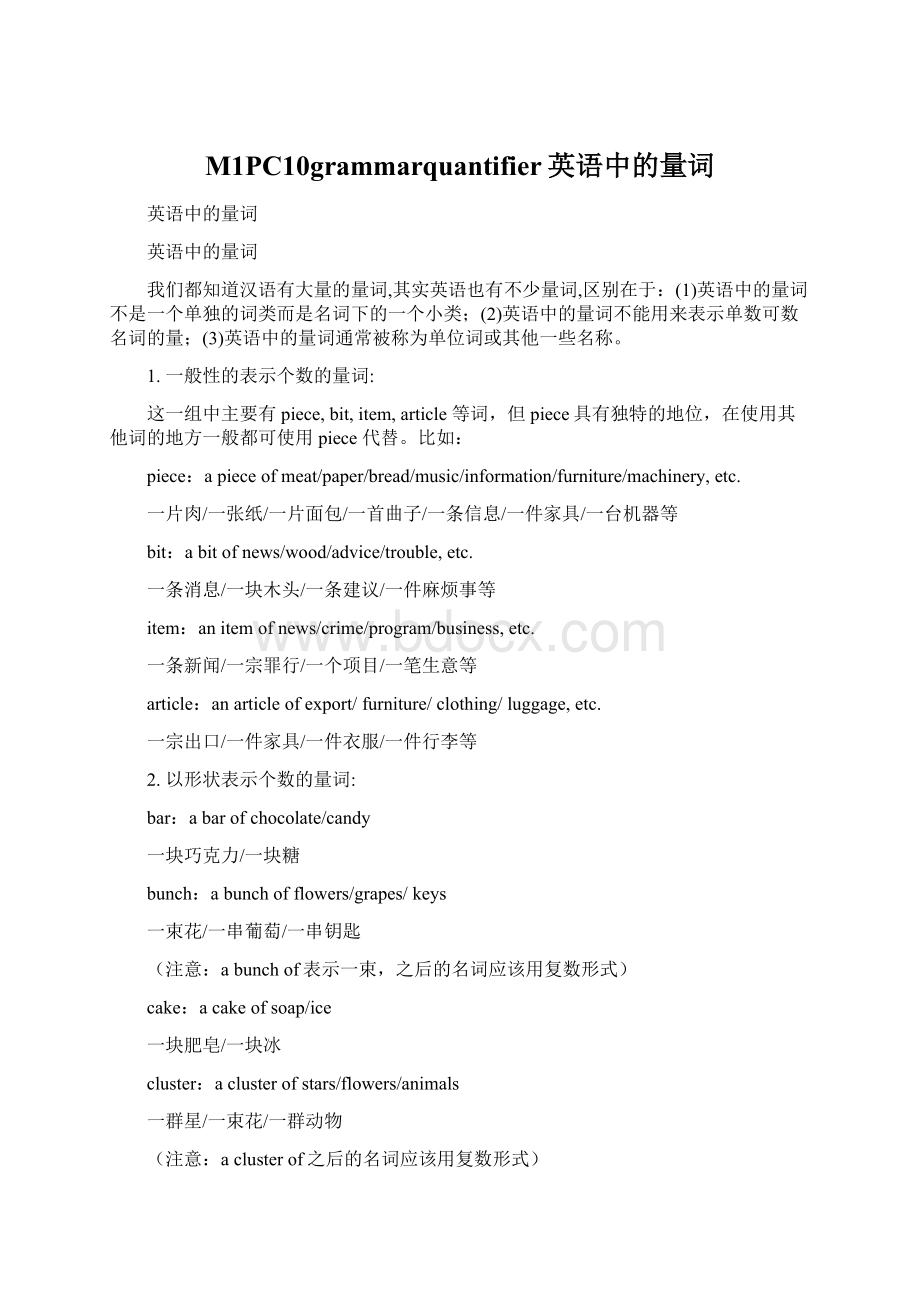M1PC10grammarquantifier英语中的量词.docx
《M1PC10grammarquantifier英语中的量词.docx》由会员分享,可在线阅读,更多相关《M1PC10grammarquantifier英语中的量词.docx(20页珍藏版)》请在冰豆网上搜索。

M1PC10grammarquantifier英语中的量词
英语中的量词
英语中的量词
我们都知道汉语有大量的量词,其实英语也有不少量词,区别在于:
(1)英语中的量词不是一个单独的词类而是名词下的一个小类;
(2)英语中的量词不能用来表示单数可数名词的量;(3)英语中的量词通常被称为单位词或其他一些名称。
1.一般性的表示个数的量词:
这一组中主要有piece,bit,item,article等词,但piece具有独特的地位,在使用其他词的地方一般都可使用piece代替。
比如:
piece:
apieceofmeat/paper/bread/music/information/furniture/machinery,etc.
一片肉/一张纸/一片面包/一首曲子/一条信息/一件家具/一台机器等
bit:
abitofnews/wood/advice/trouble,etc.
一条消息/一块木头/一条建议/一件麻烦事等
item:
anitemofnews/crime/program/business,etc.
一条新闻/一宗罪行/一个项目/一笔生意等
article:
anarticleofexport/furniture/clothing/luggage,etc.
一宗出口/一件家具/一件衣服/一件行李等
2.以形状表示个数的量词:
bar:
abarofchocolate/candy
一块巧克力/一块糖
bunch:
abunchofflowers/grapes/keys
一束花/一串葡萄/一串钥匙
(注意:
abunchof表示一束,之后的名词应该用复数形式)
cake:
acakeofsoap/ice
一块肥皂/一块冰
cluster:
aclusterofstars/flowers/animals
一群星/一束花/一群动物
(注意:
aclusterof之后的名词应该用复数形式)
3.表示容积的词:
bottle:
abottleofink/milk/wine
一瓶酒/一瓶牛奶/一瓶葡萄酒
bowl:
abowlofrice/porridge
一碗米饭/一碗粥
pail:
apailofwater一桶水
glass:
aglassofbeer一杯啤酒
cup:
acupoftea一杯茶
apacketofcigarette一包烟
4.表示行为动态的量词:
fit:
afitoflaughter一阵笑声
peal:
apealofthunder一阵雷声
flash:
aflashoflight一道闪电
你会用英语询问价格吗?
询问价格常用的句子:
What'sonsaletoday?
今天有什么特卖品吗?
Doyouhaveanythingonsale?
你们有什么特卖品吗?
Isthereadiscount?
有什么打折商品吗?
Whenwillthesalebegin?
什么时候开始减价?
Howmuchisit?
多少钱?
Howmuchisthis?
这个多少钱?
Howmuchisthisscarf?
这条围巾多少钱?
Howmuchdoesitcost?
这个要多少钱?
Howabouttheprice?
价格怎么样?
Howmuchdoyouwantforthat?
那个要价多少?
What'syourgeneralpricerange?
你要的价位是多少呢?
What'sthepriceforthejacket?
这个夹克是什么价格?
HowmuchshallIpayforit?
我该付多少钱?
HowmuchdoIoweyou?
我该付多少钱?
Couldyoutellmehowmuchitis?
你能告诉我这个多少钱吗?
Wouldyouliketotellmehowmuchitis?
你能告诉我这个多少钱吗?
I'dliketoknowhowmuchitis.我想知道这个多少钱?
回答价格常用句子:
Youwillseeitonthepricetag.标签上有。
Weask58Yuanforit.这个要58元。
Itcosts12Yuan.这个要12元。
35dollarsforonekilo.1公斤35美元。
Itis25Yuanperpiece.每件要25元。
TwobottlesofCokeareonly1dollar.两瓶可口可乐只要1美元。
It'sthesaleprice.这是减价后的价格。
Thepricedependsonthequality.按质论价。
Thepriceismarkedonthetag.价格就标在价签上。
Thesizesmakenodifferenceintheprice.大小同价。
Theleastexpensiveoneis20Yuan.最便宜的一种是20元。
3Yuanforone,and5Yuanfortwo.3元一只,买两只5元。
Allthedressesdisplayedinthisroomhaveaspecialprice.这里陈列的所有套裙都特价出售。
Wehaveaclearancesaletoday.我们今天清仓大特卖。
Itemsonthisrackare50%off.这个架子上的东西打5折。
Theyarebargain-priced.廉价出售。
Everythingisonsale.每件商品都减价出售。
Youcanbuythreeandgetonefree.你可以买三送一。
Youcansaveanextra20%.你可以额外节省20%的费用。
价格促销公示牌常用的句子:
Discount.打折。
PriceCrash.削价。
Sale/OnSale/SpecialSale/SpecialOffer.特价。
HolidaySale.节日促销。
DailySpecial.今日特价。
SummerPriceCuts.夏季大削价。
DiscountClothes.打折服装。
BigSale.大甩卖。
ClearanceSale.清仓处理。
DiscountEverything.全场折扣。
ClosingSale.关门大甩卖。
CardPrice.会员价。
ShowYourCardAndSave.凭会员卡享受优惠价
BuyOneAndGetOneFree.买一赠一。
RegularPrice.原价。
20%Off.降价20%/八折优惠。
HalfPrice.半价。
HalfPriceSale.半价甩卖。
.
讨价常用的句子:
Bargainwithsomebodyonsomething.和某人关于某物品讨价还价。
Areyougoodatbargainingwhenyoubuyclothes?
当你买衣服时你是杀价高手吗?
It'salittleexpensive.有点贵了。
That'salittlemorethanIwanttopay.这比我要买的价格高了一些。
That'sexpensive.很贵呀。
Thatmuch!
那么多呀!
It'soverourbudget.这超出了我们的预算。
Ithinkthepriceisnotreasonable.我认为价格不合理。
Haveyougotanythingalittlecheaper?
有便宜一点的吗?
Canitbecheaper?
能便宜一点吗?
IfIbuymorethanone,willyougivemeadiscount?
多买一点有折扣吗?
Gavemeadiscount.给我打个折吧。
Anydiscount?
可不可以打打折呀?
Howaboutadiscount?
打个折怎么样?
Areyouhavingasalenow?
你们现在在打折吗?
Isthereadiscountonthisitem?
这个东西有折扣吗?
Couldyougivemeadiscount?
你能给我折扣吗?
Isthisoneonsale?
这个打折吗?
CanIhaveadiscountforthisjacket?
这件夹克能给我打折吗?
I'veseenthischeaperinotherplaces.我在别家看过更便宜的。
Icangetthischeaperatotherplaces.这样的东西我在别的地方可以买到更便宜的。
What'sthelowestyou'rewillingtogo?
最低你能出什么价?
I'llgiveyou55RMB.我给你55块钱。
Howabouttwentydollars?
20美元怎么样?
Allright,I'lltakeit.好吧,我买了。
现在进行时用法归纳
基本用法:
1.表示说话时正在进行的动作,强调“此时此刻”,常和now,look,listen连用。
Look!
Atrainiscoming.看,火车来了。
Listen!
Heisplayingthepiano.听,他在弹琴。
2.表示现阶段正在进行的事情,不一定说话时正在进行。
常和atpresent,thisweek,these
days等时间状语连用。
Whatlessonareyoustudyingthisweek?
你们本周学哪一课了?
(说话时并不在学)
3.现在进行时有时可用来表示一个最近按计划或安排要进行的动作,即用现在进行时代替一般将来时,动词一般多为表示位置移动的动词。
如:
go,come,leave等。
Whereareyougoing?
你去哪?
Iamcoming.我来了。
AreyougoingtoTianjintomorrow?
你明天去天津吗?
Howmanyofyouarecomingtothepartynextweek?
你们有多少人下周要来参加晚会?
4.wear用现在进行时表示一种状态。
Heiswearingabluecoat.他穿着一件蓝外套。
5.有些动词意思只是表示一种状态,不能用于现在进行时。
如:
have(有),like等。
Noweachofushasadictionary.现在我们每一个人都有一本词典。
现在分词变化规则:
1.一般情况,在动词词尾加上-ing。
如:
jump----jumping
2.以不发音字母-e结尾的动词,先去e,再加-ing。
如:
have----having write----writingmake----making,taste----tasting come----comingtake----takinghope----hoping
3.以重读闭音节结尾,即一个元音字母加一个辅音字母,且不为字母组合,则双写末尾的辅音字母,再加-ing。
如:
run----running sit----sitting put----putting stop----stopping
get----getting run----runningcut----cuttingrun----runningshop----shoppingswim----swimming set----setting
4.以-ie结尾的动词,改-ie为y加-ing。
如:
die----dying lie----lying tie----tying
特别提醒:
①容易拼错的现在分词:
opening,drawing,studying,listening,cleaning,eating,raining,seeing,lying,writing,forgetting,beginning,preferring。
②动词变现在分词可有如下口诀:
“一添一去y不变”。
“一添”指双写规则;“一去”指去掉不发
音字母e规则;“y不变”指要与名词变复数区分开。
现在进行时的肯定肯定句、否定句、疑问句形式:
主语
肯定句
否定句
疑问句
第一、二人称和第三人称复数以及名词复数
Iamdriving.
He/She/Itisworking.
We/You/Theyaredoingsomething.
Iamnotdriving.
He/Sheisnotworking.
We/You/Theyarenotdoinganything.
Areyoudriving?
Ishe/sheworking?
Areyou/theydoingsomething?
用所给动词的适当形式填空:
1. It’steno’clock.Mymother_________(lie)inbed.
2. What_______he________(mend)now?
3. We___________(play)gamesnow.
4. ________he________(clean)theclassroom?
Yes,heis.
5.Whatareyou_________(do)now?
I___________(eat)bread.
6.It’snineo’clock.Myfather_______________(work)intheoffice.
7.Look,theboy____________(put)therubbishintothebin.
8. WhereisMark?
He___________(run)onthegrass.
9. Listen,who____________(sing)inthemusicroom?
10. Myfatheralways__________(come)backfromworkverylate.
11.Theteacherisbusy.He__________(sleep)sixhoursaday.
12.Theboy________(draw)apicturenow.
13.Mymother__________(cook)somenicefood now.
14.They________(notwater)theflowersnow.
15. Look!
thegirls________________(dance)intheclassroom.
16.Whatisourgranddaughterdoing?
She________(listen)tomusic.
17. It’s 5 o’clock.We_____________(have)suppernow
18.______Helen____________(wash)clothes?
Yes,sheis.
19.Don’ttalkhere.Mymother__________(sleep).
20.Themanis___________(open)thedoorforus.Let’shurry.
Keys:
1.islying 2.is,mending 3.areplaying 4.Is,cleaning 5.doing;ameating
6.isworking 7.isputting 8.Isrunning 9.issinging 10.comes
11.sleeps 12.isdrawing 13.iscooking 14.arenotwatering 15.aredancing
16.islistening 17.arehaving 18.Is,washing 19.issleeping 20.opening
常用一般将来时表示法
一般将来时表示将来某一时刻的动作或状态,或将来某一般时间内经常发生的动作或状态。
和一般将来时连用的时间状语有tomorrow明天,thedayaftertomorrow后天,thisafternoon/evening今天下午/晚上,nextweek(month,year,summer)下一周(月、年、夏天),intwoweeks(days,month)两周(天,月)后等。
一、常用表示法:
1、begoingto+动词原形
表示将要发生的事,或打算、计划、决定要做的事情。
其中:
be(am/is/are)随主语人称而变化。
肯定式:
主语+be+gongtodo;
否定式:
主语+benot+gongtodo;
疑问式:
be+主语+gongtodo?
例如:
IamgoingtoplayfootballnextSunday.下周日我打算踢足球。
Heisgoingtotravelaroundtheworld.他计划周游世界。
I'mnotgoingtobeateacher.我不打算当老师。
——Areyougoingtobeadoctorwhenyougrowup?
你长大了,打算当一名医生吗?
——Yes,Iam.是的,我打算当。
——No,I'mnot.不,我不打算当。
注意:
begoingto后面的动词一定要用原形。
2、主语+will(shall)+动词原形
表示将来打算进行或期待发生的动作或状态。
肯定句:
主语+will(shall)+动词原形;
否定句:
主语+will(shall)not+动词原形;
疑问句:
Will(Shall)+主语+动词原形。
例如:
Iwillcallyouthisevening.今天晚上我会给你电话。
Hewon'thavetimetoreadEnglish.他不会有时间读英语的。
——Willhebebackintwodays?
两天后,他会回来吗?
——Yes,hewill.是的,他会。
——No,hewillnot.不,他不会。
注意:
在书面语中,主语是第一人称I(We)时,常用shall,即I(We)+shall+动词原形,也可用will。
例如:
Shallwehaveanyclasstomorrow?
明天我们有课吗?
——Yes,wewill(weshall).是的,我们明天有课。
——No,wewon't(weshallnot).不,明天我们没课。
二、其他表示法:
1、一般现在时表示将来:
一般将来式可用现在进行时代替,表示“按计划或时刻表”要发生的事。
另外,在if引导的条件状语从句和assoonas引导的时间状语从句中,一般现在时表示将来。
例如:
Theplanesetsoffatnine.飞机九点起飞。
We’llstayathomeifitrainstomorrow.如果明天下雨,我们就呆在家里。
I’llcallyouassoonashegetshome.他明天一到家我就打电话通知你。
2、进行时表示将来:
一般将来使还可用现在进行时,表示“按计划安排”要发生的事。
这种用法的一般是短暂性动词,如:
come,go,leave,arrive,begin,start,die等。
例如:
Mum,I’mcoming.妈妈,我就来。
HeisleavingforShanghaitomorrow.他明天要动身去上海。
3、beto表将来,表示“计划安排”要做的事,具有“必要”的强制性意义。
例如:
Youaretoplaytennisthisafternoon.你今天下午必须打网球。
4、beaboutto表将来,表示即将发生的事情。
例如:
Hewasabouttostart.他就要动身了。
练习:
用括弧中动词的适当形式填空
1.When____Mike____(arrive)heretomorrow?
2.He____(be)backinthreehours.
3.I____(buy)ahousewhenwesaveenoughmoney.
4.They____(make)progresssoon.
5.Ifheisn'tfreetomorrow,he____(nottake)partintheparty.
6.Ifhe___(have)time,he___(go)tothecinemathatnight.
7.Wewon'tgountilyou___(come)soon.
8.Ifshe___(return)I___(let)youknow.
9.We___(send)foradoctorifyou___(be)notbetterintheevening.
10.She_____(have)aconcertthenextyear.
Keys:
1、will…arrive2、willbe3、amgoingtobuy
1.areto5、willnottake6、has,willgo7、come
8、returns,willlet9、willsend,are10、willhave
Jobs工作
HerearesomeEnglishphrasesfortalkingaboutjobs,whichwillallowyoutodiscussthetypeofjobsyoudoandwhereyouwork.下面是一些谈论工作时常用的英语表达,谈论你的工作类型和在哪里工作时可能会用到这些表达。
Occupation职业
Whatdoyoudo?
你是做什么工作的?
Whatdoyoudofo